Related Research Articles

A geared steam locomotive is a type of steam locomotive which uses gearing, usually reduction gearing, in the drivetrain, as opposed to the common directly driven design.
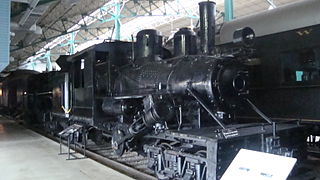
A Climax locomotive is a type of geared steam locomotive built by the Climax Manufacturing Company, of Corry, Pennsylvania. These had two steam cylinders attached to a transmission located under the center of the boiler, which sent power to driveshafts running to the front and rear trucks. Some 1000-1100 were built in three classes - A, B, and C - between 1888 and 1928.

The Heisler locomotive is one of the three major types of geared steam locomotives and the last to be patented.

The Pittsburgh Locomotive and Car Works was a railroad equipment manufacturing company founded by Andrew Carnegie and T.N. Miller in 1865. It was located in Allegheny, Pennsylvania, a suburb of Pittsburgh and since 1907 part of that city.

The Chicago, Burlington and Quincy Railroad was a railroad that operated in the Midwestern United States. Commonly referred to as the Burlington Route, the Burlington, or as the Q, it operated extensive trackage in the states of Colorado, Illinois, Iowa, Missouri, Nebraska, Wisconsin, Wyoming, and also in Texas through subsidiaries Colorado and Southern Railway, Fort Worth and Denver Railway, and Burlington-Rock Island Railroad. Its primary connections included Chicago, Minneapolis–Saint Paul, St. Louis, Kansas City, and Denver. Because of this extensive trackage in the midwest and mountain states, the railroad used the advertising slogans "Everywhere West", "Way of the Zephyrs", and "The Way West".
The Central Vermont Railway was a railroad that operated in the U.S. states of Connecticut, Massachusetts, New Hampshire, New York, and Vermont, as well as the Canadian province of Quebec.

The Railroad Museum of Pennsylvania is a railroad museum in Strasburg, Lancaster County, Pennsylvania.

The Roaring Camp & Big Trees Narrow Gauge Railroad is a 3 ft narrow-gauge tourist railroad in California that starts from the Roaring Camp depot in Felton, California and runs up steep grades through redwood forests to the top of nearby Bear Mountain, a distance of 3.25 miles.

Cass Scenic Railroad State Park is a state park and heritage railroad located in Cass, Pocahontas County, West Virginia.
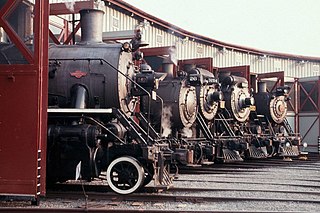
Steamtown National Historic Site (NHS) is a railroad museum and heritage railroad located on 62.48 acres (25.3 ha) in downtown Scranton, Pennsylvania, at the site of the former Scranton yards of the Delaware, Lackawanna and Western Railroad (DL&W). The museum is built around a working turntable and a roundhouse that are largely replications of the original DL&W facilities; the roundhouse, for example, was reconstructed from remnants of a 1932 structure. The site also features several original outbuildings dated between 1899 and 1902. All the buildings on the site are listed with the National Register of Historic Places as part of the Delaware, Lackawanna and Western Railroad Yard-Dickson Manufacturing Co. Site.

The Yosemite Mountain Sugar Pine Railroad (YMSPRR) is a historic 3 ft narrow gauge railroad with two operating steam train locomotives located near Fish Camp, California, in the Sierra National Forest near the southern entrance to Yosemite National Park. Rudy Stauffer organized the YMSPRR in 1961, utilizing historic railroad track, rolling stock and locomotives to construct a tourist line along the historic route of the Madera Sugar Pine Lumber Company.

The Sumpter Valley Railway, or Sumpter Valley Railroad, is a 3 ft narrow gauge heritage railroad located in Baker County, in the U.S. state of Oregon. Built on a right-of-way used by the original railway of the same name, it carries excursion trains on a roughly 5-mile (8.0 km) route between McEwen and Sumpter. The railroad has two steam locomotives and several other pieces of rolling stock. Passenger excursion trains operate on weekends and holidays from Memorial Day through the end of September.
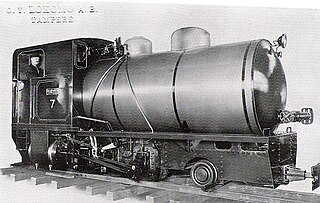
A fireless locomotive is a type of locomotive which uses reciprocating engines powered from a reservoir of compressed air or steam, which is filled at intervals from an external source. They offer advantages over conventional steam locomotives of lower cost per unit, cleanliness, and decreased risk from fire or boiler explosion; these are counterbalanced by the need for a source to refill the locomotive, and by the limited range afforded by the reservoir.

The Borate and Daggett Railroad was a 3 ft narrow gauge railroad built to carry borax in the Mojave Desert. The railroad ran about 11 miles (18 km) from Daggett, California, US, to the mining camp of Borate, three miles (4.8 km) to the east of Calico.
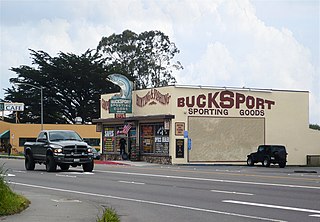
Bucksport was a town in Humboldt County, California. The original location was 2.5 miles (4 km) southwest of downtown Eureka, on Humboldt Bay about 5 miles (8 km) northeast of entrance. at an elevation of 16 feet (4.9 m). Prior to American settlement a Wiyot village named Kucuwalik stood here.
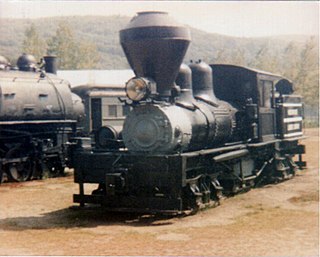
Steamtown, U.S.A., was a steam locomotive museum that ran steam excursions out of North Walpole, New Hampshire, and Bellows Falls, Vermont, from the 1960s to 1983. The museum was founded by millionaire seafood industrialist F. Nelson Blount. The non-profit Steamtown Foundation took over operations following his death in 1967. Because of Vermont's air quality regulations restricting steam excursions, declining visitor attendance, and disputes over the use of track, some pieces of the collection were relocated to Scranton, Pennsylvania in the mid-1980s and the rest were auctioned off. After the move, Steamtown continued to operate in Scranton but failed to attract the expected 200,000–400,000 visitors. Within two years the tourist attraction was facing bankruptcy, and more pieces of the collection were sold to pay off debt.

Canadian Pacific 1293 is a class "G5d" 4-6-2 "Pacific" type steam locomotive built in June 1948 by the Canadian Locomotive Company for the Canadian Pacific Railway. Built for passenger service, 1293 served an eight-year career until being replaced by diesel locomotives where it was then retired in 1959. Purchased in 1964 by F. Nelson Blount for use at his Steamtown site in Bellows Falls, Vermont, 1293 was easily restored to operation for hauling fan trips for the general public. 1293 was later sold to the Ohio Central Railroad in 1996 for tourist train service. Today, the locomotive is out on display at the Age of Steam Roundhouse in Sugarcreek, Ohio.
The Massawippi Valley Railway was a short line railway established in 1870 between Lennoxville, Quebec, and the Vermont border. Part of the Quebec Central Railway from 1926, the line was abandoned in 1990 and removed in 1992. Most of the former railway's right of way is now used for bicycle trails.

Phenix is an unincorporated community in northwest Greene County, in the U.S. state of Missouri. The community is located on the banks of Sugar Creek, approximately 2.5 miles south of Walnut Grove and 1.5 miles west of Harold and Missouri Route 123.
References
- ↑ "Passumpsic Railroad". www.passumpsicrailroad.com. Archived from the original on September 21, 2017. Retrieved 10 August 2021.
- ↑ "Passumpsic Heisler". www.rypn.org. Railway Preservation News. Retrieved 10 August 2021.
- ↑ "PASSUMPSIC RAILROAD, INC. :: Vermont (US) :: OpenCorporates". opencorporates.com. Retrieved 10 August 2021.